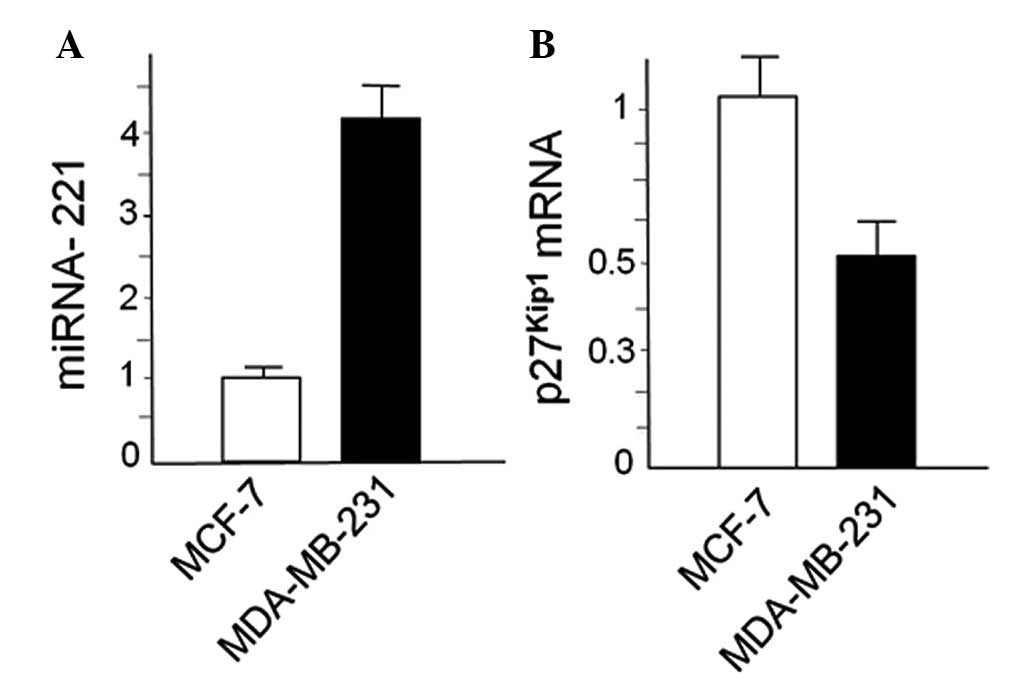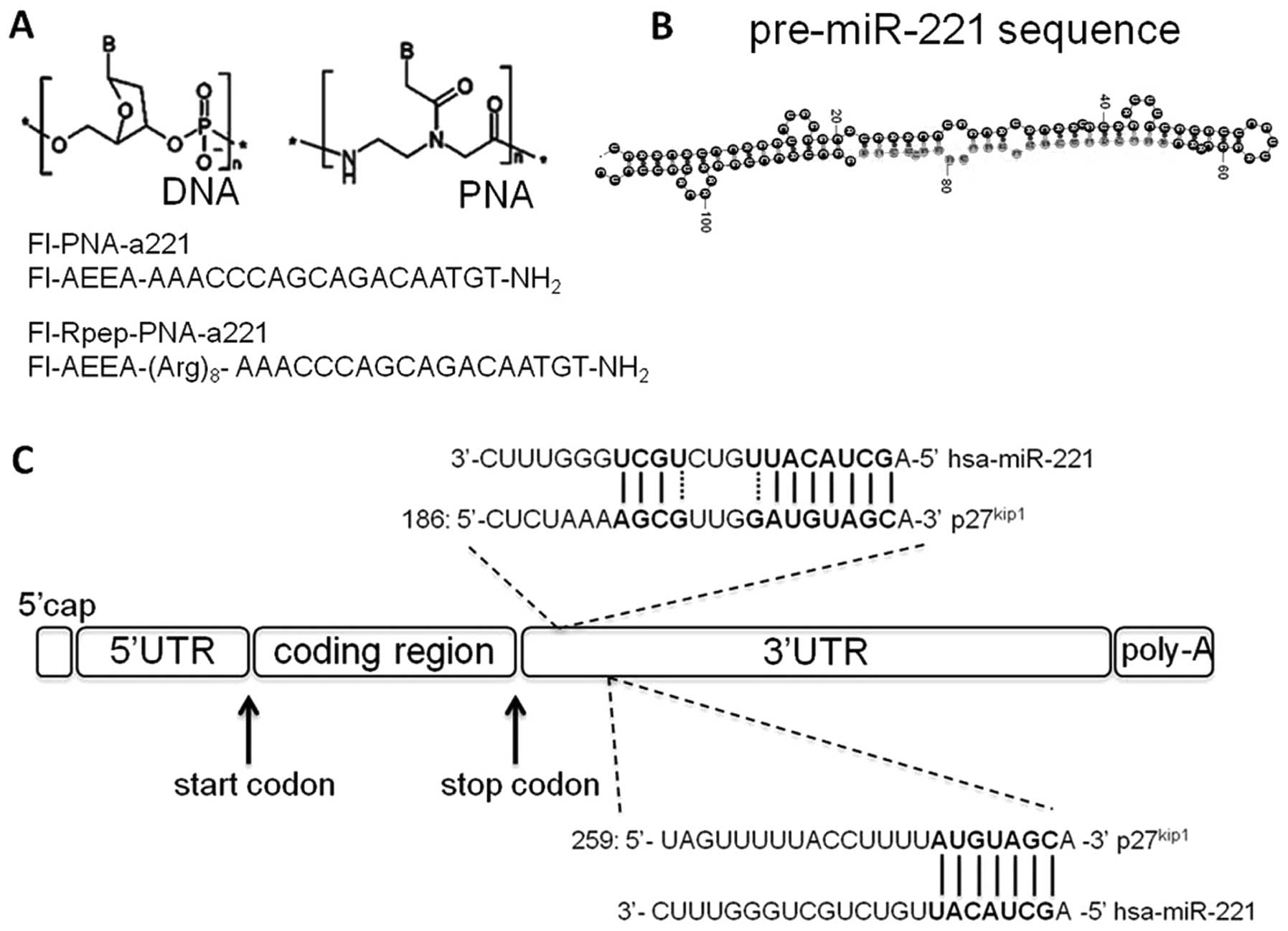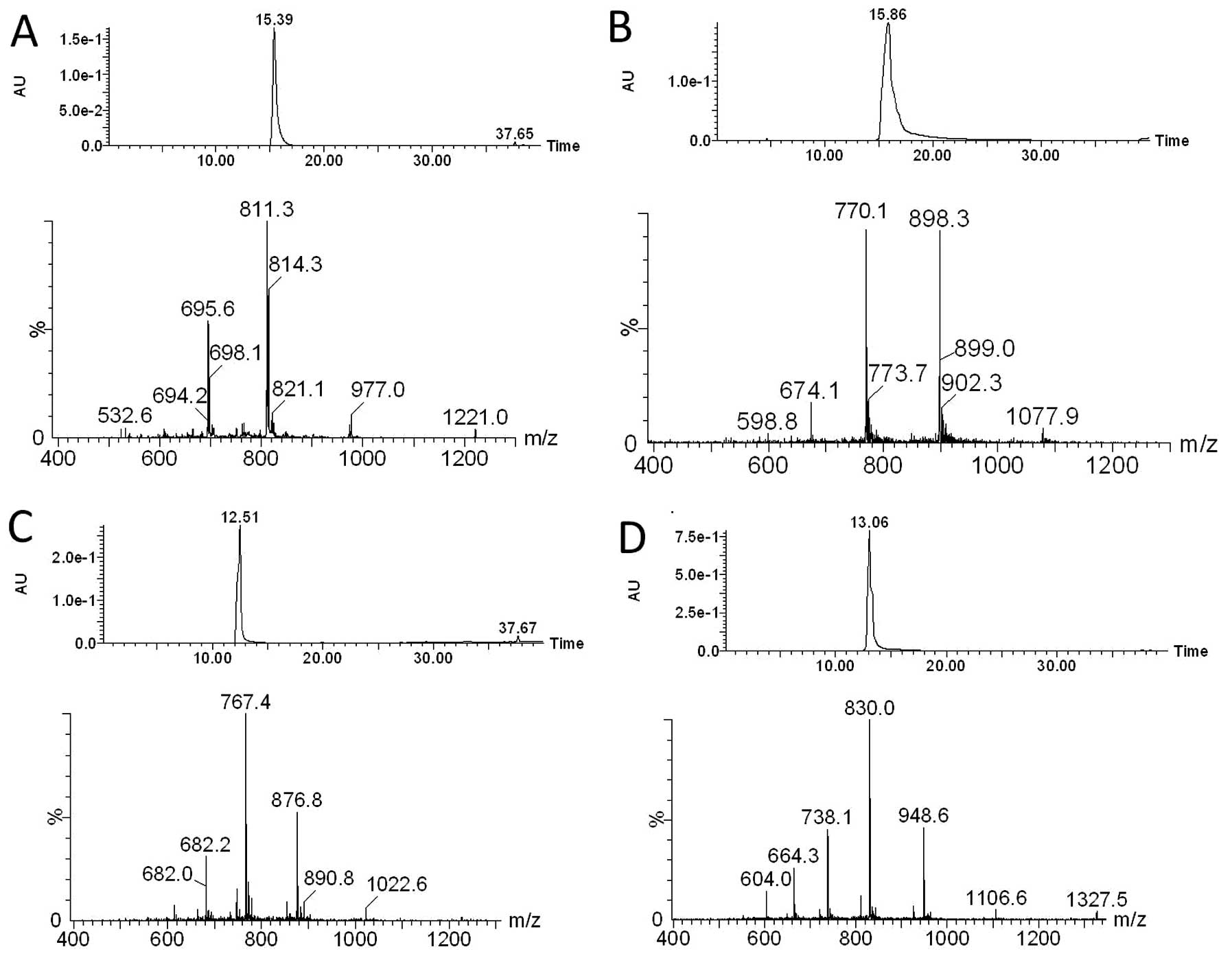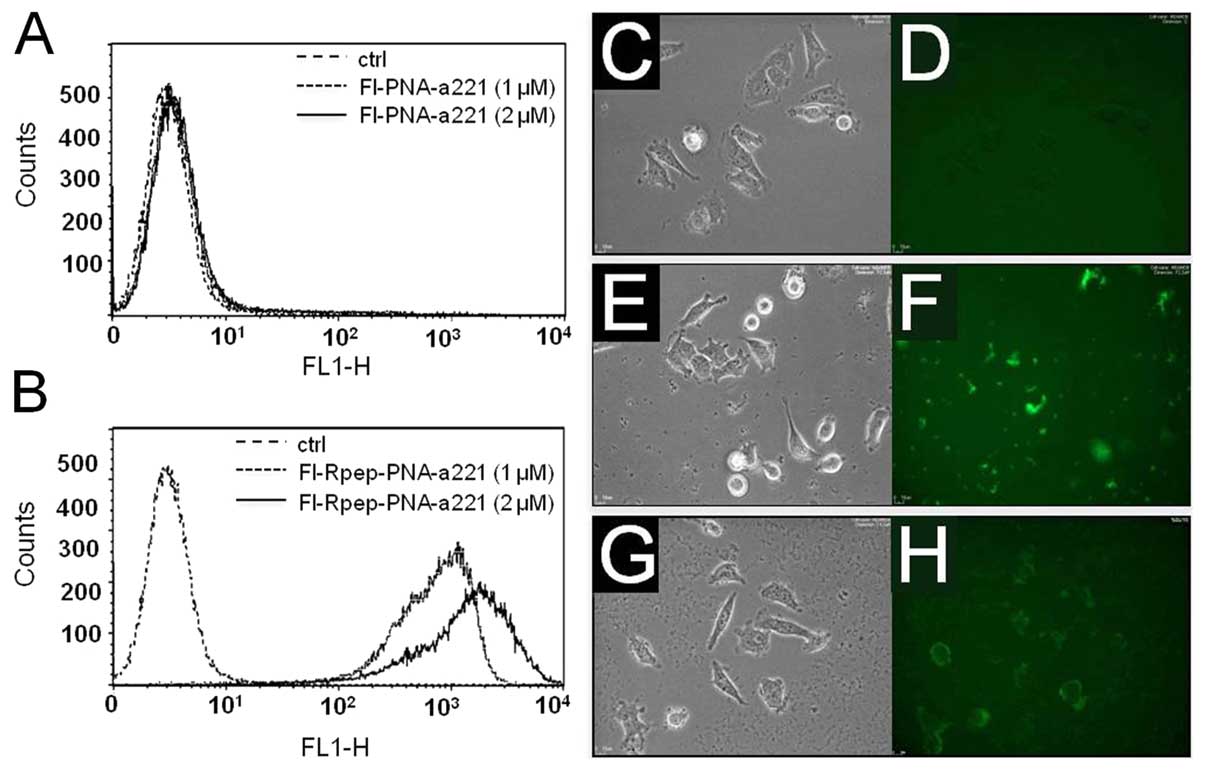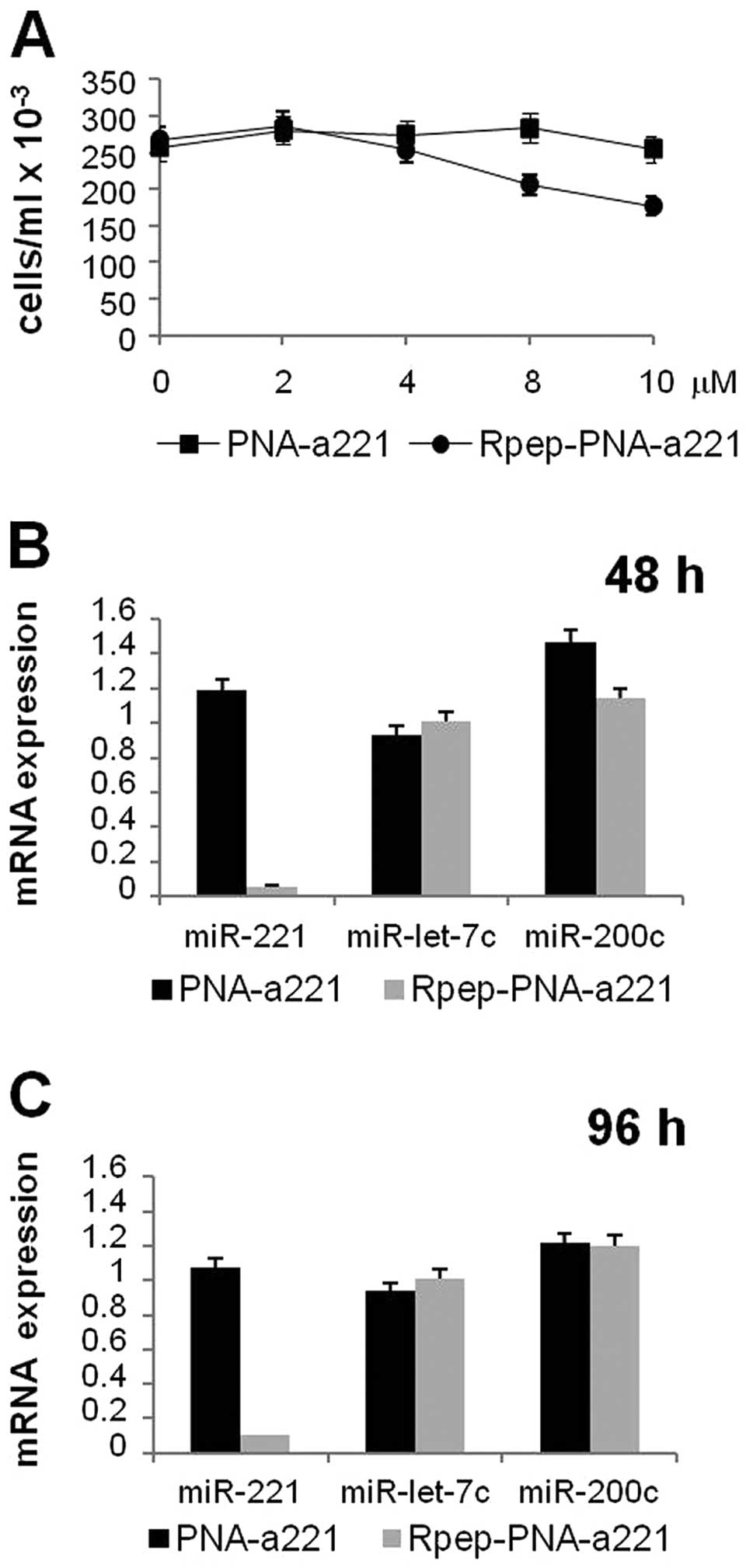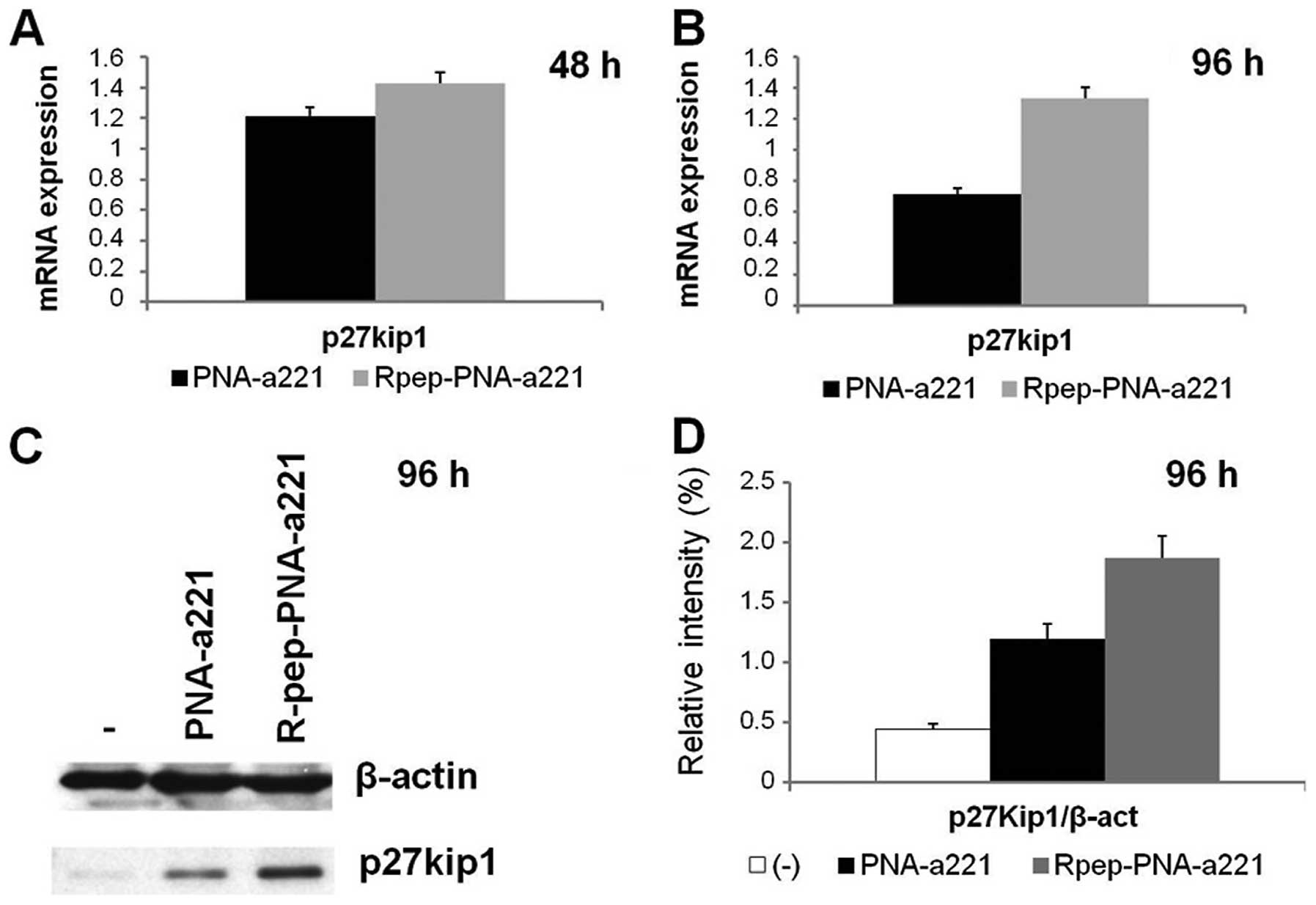Peptide nucleic acids targeting miR-221 modulate p27Kip1 expression in breast cancer MDA-MB-231 cells
- Authors:
- Published online on: September 19, 2012 https://doi.org/10.3892/ijo.2012.1632
- Pages: 2119-2127
Abstract
Introduction
MicroRNAs (miRNAs, miRs) are a family of small (19 to 25 nucleotides in length) non-coding RNAs that regulate gene expression by sequence-selective targeting of mRNAs (1–4), leading to a translational repression or mRNA degradation, depending on the degree of complementarity between miRNAs and the target sequences (2). Since a single miRNA can target several mRNAs and a single mRNA may contain several signals for miRNA recognition, it is calculated that at least 10–40% of human mRNAs are targets of microRNAs (2). In general, a low expression of a given miRNA is expected to be potentially linked with an accumulation of targets mRNAs; conversely, a high expression of miRNAs is expected to be the cause of a low expression of the target mRNAs.
miRNAs play a double role in cancer, behaving both as tumor promoters or tumor suppressors. In general, cancer-promoting miRNAs target mRNA coding for tumor-suppression proteins, while miRNAs exhibiting tumor-suppression properties usually target mRNAs coding oncoproteins. MicroRNAs which have been demonstrated to play a crucial role in the initiation and progression of human cancer are defined as oncogenic miRNAs (oncomiRs) (5). Moreover, miRNAs have been firmly demonstrated to be involved in cancer metastasis (metastamiRs) (6). Thus, therapeutic strategies involving miRNA silencing have been proposed based on the roles of these small non-coding RNAs as oncogenes.
One of the most interesting microRNAs possibly involved in cancer is miR-221. This miRNA has been found to be upregulated in breast cancer (7), glioma (8), hepatocellular carcinoma (9), pancreatic adenocarcinoma (10), melanoma (11), chronic lymphocytic leukemia (12), thyroid papillary carcinoma (13). Possible target molecules of miR-221 are DVL2 (14), PUMA (15), PTEN (16), p27Kip1 (17–19). In this specific context, of great interest is the study published by Galardi et al identifying p27Kip1 mRNA as a possible target of miR-221 (20). This finding is very intriguing, since p27Kip1 has been proposed as a tumor suppressor gene, which is downregulated in several types of tumors.
In consideration of the involvement of miRNAs in cancer (7–13), the possibility to regulate gene expression by interfering with the fundamental mechanisms mediated by miRNAs is one of the most intriguing challenges in the development of new types of drugs (miRNA therapeutics) in cancer. In this respect peptide nucleic acid (PNA)-based molecules are appealing (21–23).
PNAs are DNA mimics extensively used for the pharmacological regulation of gene expression in a variety of cellular and molecular systems (21–23). In PNAs the pseudo-peptide backbone is composed of N-(2-aminoethyl)glycine units (24). PNAs are resistant to both nucleases and proteases (25–27) and, more importantly, hybridize with high affinity to complementary sequences of single-stranded RNA and DNA, forming Watson-Crick double helices (28–31). For these reasons, PNAs were found to be excellent candidates for antisense and antigene therapies (32–34). In addition, PNA-based molecules (such as PNA-DNA chimeras) can act as transcription factor decoys as demonstrated in the case of NF-κB and Sp1 (34).
The major limit in the use of PNAs for alteration of gene expression is the low uptake by eukaryotic cells (35). In order to solve this drawback, several approaches have been considered, including the delivery of PNA analogues with liposomes and microspheres (25,36,37). One possible strategy is to link the PNAs to polylysine (K) or a polyarginine (R) tails, based on the observation that these cell-membrane penetrating oligopeptides are able to facilitate uptake of conjugated molecules (38). Peptide-PNA conjugates have been shown to be efficiently incorporated in cells by gymnosis, i.e. without the need of transfecting agents, showing high uptake efficiency (39).
At present, data on the use of PNAs as molecules targeting miRNAs are accumulating. Fabani et al reported two studies, one on PNAs against miR-122, the other on PNAs against miR-155, demonstrating the potential role of PNA for future therapeutic applications as well as for studying microRNA functions (40,41).
A further example has been recently reported by Yan et al (42), who addressed the potential effects of PNA-antimiR-21 in vivo on the growth of breast cancer cells. In their experiments, MCF-7 cells treated with PNA-antimiR-21 or PNA-control were subcutaneously injected into female nude mice and detectable tumor masses were seen in only 5/8 of mice in the MCF/PNA-antimiR-21 group, while much larger tumors were detected in all mice in the MCF/PNA-control group. Both tumor weight and number showed that MCF/PNA-control cells formed larger tumors more rapidly than MCF/PNA-antimiR-21 cells in nude mice (42). Regarding possible effects of PNAs against microRNAs on biological functions, our group recently reported a study on the effect of PNA molecules targeting miR-210 in K562 cells. We have previously found that this microRNA is upregulated during induced erythroid differentiation (43). Treatment of K562 cells with this PNA molecule leads, as expected, to a sharp decrease of differentiation levels (44). An octa-arginine-PNA conjugate was found to be efficiently delivered within the cells and showed high inhibitory effects on miRNA-210 bioavailability.
The aim of the present study was to determine the activity of PNA designed according to the same model, and targeted against miR-221 on the biological activity of this miRNA, in particular on its effects on p27Kip1. As a model system, we employed the human breast cancer cell line MDA-MB-231, in which miR-221 is upregulated and p27Kip1 downregulated (45). In addition, this cell line is suitable to address specific effects on miR-221, since it accumulates far more miR-221 in respect to miR-222.
We first describe the designed and synthesized PNA against miR-221. Second, we described and validated the delivery strategy to maximize PNA uptake by target MDA-MB-231 cells. Third, we analyzed the effects of anti-miR PNA on miR-221 accumulation and biological effects on MDA-MB-231 cells.
Materials and methods
Synthesis and characterization of PNAs
The synthesis of peptide Fl-Rpep was performed as previously reported (46). The PNAs were synthesized with standard manual Boc-based chemistry using commercially available monomers (ASM Research Chemicals, Hannover, Germany) with HBTU/DIPEA coupling as described elsewhere (46). All the PNAs were synthesized in a 5 μmol scale using MBHA resin loaded with Boc-PNA-T-OH as first monomer. The R8 tail of Rpep-PNA-a221 was introduced using the same coupling procedures. 5(6)-carboxyfluorescein (Sigma-Aldrich) was introduced using DIC/DhBtOH coupling after the coupling of the PNA or PNA-peptide conjugate with 2-(2-(Fmoc-amino) ethoxy)ethoxyacetic acid (AEEA) spacer (Applied Biosystems, Foster City, CA, USA).
PNA purification was performed by RP-HPLC with UV detection at 260 nm using a semi-prep column C18 (for unlabelled PNA: 5 microns, 250×10 mm, Jupiter Phenomenex, 300 Å; for fluorescein labeled PNAs: 10 microns, 300×7.7 mm, Xterra Waters, 300 Å), eluting with water containing 0.1% TFA (eluent A) and acetonitrile containing 0.1% TFA (eluent B); elution gradient: from 100% A to 50% B in 30 min, flow: 4 ml/min. Purity and identity of the purified PNAs were checked by HPLC-MS (Micromass Quattro micro API with QqQ Detector) using a Phenomenex Jupiter C18; 250×4.6 mm; 5 μm column.
PNA-a221
Yield: 16%; calculated MW: 4881.0; ESI-MS: m/z found (calculated): 122.0 (1221.9) [MH44+], 976.9 (977.7) [MH55+], 814.3 (815.0) [MH66+], 698.2 (698.7) [MH77+].
Rpep-PNA-a221
Yield: 47%; calculated MW: 5386.8; ESI-MS: m/z found (calculated): 1077.9 (1078.9) [MH55+], 898.3 (899.3) [MH66+], 770.1 (771.0) [MH77+], 674.1 (674.7) [MH88+].
Fl-PNA-a221
Yield: 27%; calculated MW: 6129,8; ESI-MS: m/z found (calculated): 1022.6 (1023.2) [MH6+], 876.8 (877.2) [MH7+], 767.4 (767.7) [MH8+], 682.2 (682.5) [MH9+], 614.0 (614.3) [MH1010+].
Fl-Rpep-PNA-a221
Yield: 29%; calculated MW: 6635.6; ESI-MS: m/z found (calculated): 1327.5 (1328.8) [MH55+], 1106.6 (1107.5) [MH66+], 948.6 (949.5) [MH77+], 830.0 (830.9) [MH88+], 738.1 (738.7) [MH99+], 664.3 (664.9) [MH1010+], 604.0 (604.6) [MH1111+].
UV measurements
Stock solutions of Rpep-PNA-a221, and of complementary DNA or RNA synthetic oligonucleotides (Thermo Fisher Scientific, Ulm, Germany, HPLC grade), with the following sequences: full match: 5′-ACATTGTCTGCTGGGTTT-3′; mismatch: 5′-ACATTGTCAGCTGGGTTT-3′; scrambled 5′-GTTCGTATGCTATTTGGC-3′, were prepared in double distilled water and the PNA concentration calculated by UV absorbance using the following ε260 (M−1 cm−1) for the nucleobases: T 8600, C 6600, A 13700, G 11700. For DNA and RNA the data provided by the producer were used. From these, solutions containing single stranded PNA, DNA, RNA or PNA:DNA and PNA:RNA duplexes were prepared. Measurement condition: [PNA] = [DNA] or [RNA] = 5 μM in pH 7.0 PBS buffer (100 mM NaCl, 10 mM NaH2PO4•H2O, 0.1 mM EDTA) or in the same buffer containing 5 M urea. All the samples were first incubated at 90°C for 5 min, then slowly cooled to room temperature. Thermal denaturation profiles (Abs vs. T) of the hybrids were measured at 260 nm with a UV/Vis Lambda Bio 20 Spectrophotometer equipped with a Peltier Temperature Programmer PTP6 interfaced to a personal computer, in the range, 18–90°C (0.1°C step resolution). A melting curve was recorded for each duplex. The melting temperature (Tm) was determined from the maximum of the first derivative of the melting curves.
Human cell lines and culture conditions
Human breast cancer MCF-7 and MDA-MB-231 cells (47) were cultured in humidified atmosphere of 5% CO2/air in DMEM medium (Life Technologies, Monza, Italy) supplemented with 10% fetal bovine serum (FBS) (Celbio, Milan, Italy), and 2 mM L-glutamine (Sigma-Aldrich, St. Louis, MO, USA). To determine the effects on proliferation, cell growth was monitored by determining the cell number/ml using a Z1 Coulter Counter (Coulter Electronics, Hialeah, FL, USA).
RNA extraction
Cells were trypsinized and collected by centrifugation at 1,500 rpm for 10 min at 4°C, washed with PBS, and lysed with Tri-Reagent™ (Sigma-Aldrich), according to manufacturer’s instructions. The isolated RNA was washed once with cold 75% ethanol, dried and dissolved in nuclease-free pure water before use.
Real-time quantitative PCR
For microRNA quantification using real-time RT-qPCR reagents, the primers and probes were obtained from Applied Biosystems. Reverse transcriptase (RT) reactions were performed using the TaqMan® MicroRNA Reverse Transcription Kit (Applied Biosystems); real-time PCR was performed according to the manufacturer’s protocols. For each sample 20 ng were used for the assays. All RT reactions, including no-template controls and RT-minus controls, were performed in duplicate using the 7700 Sequence Detection System version 1.7 (Applied Biosystems). The relative expression was calculated using the comparative cycle threshold method and as reference U6 snRNA was used to normalize all RNA samples, since it remains constant in the assayed samples by miR-profiling and quantitative RT-PCR analysis, as previously reported (43,44).
TaqMan RT-qPCR
For gene expression analysis 1 μg of the total-RNA were reverse transcribed by using random hexamers. Quantitative real-time PCR assays were carried out using gene-specific double fluorescently labeled probes. Primers and probes used to assay p27Kip1 (assay ID: Hs00153277.m1) were purchased from Applied Biosystems. The relative expression was calculated using the comparative cycle threshold method and, as reference genes, the endogenous control human 18S rRNA (43).
Western blotting
Cytoplasmic extracts (20 μg) were denatured for 5 min at 98°C in 1X SDS sample buffer [62.5 mM Tris-HCl pH 6.8, 2% SDS, 50 mM dithiotreithol (DTT), 0.01% bromophenol blue, 10% glicerol] and loaded on SDS-PAGE gel (10×8 cm) in Tris-glycine buffer (25 mM Tris, 192 mM glycine, 0.1% SDS). A biotinylated protein ladder (size range of 9–200 kDa) (Cell Signaling Technology, Euroclone S.p.A., Pero, Italy) was used as standard to determine molecular weight. The electrotransfer to 20 microns nitrocellulose membrane (Pierce, Euroclone S.p.A.) was performed overnight at 360 mA and 4°C in electrotransfer buffer (25 mM Tris, 192 mM glycine, 5% methanol). The membrane were prestained in Ponceau S Solution (Sigma) to verify the transfer, washed with 25 ml TBS (10 mM Tris-HCl pH 7.4, 150 mM NaCl) for 10 min at room temperature and incubated in 25 ml of blocking buffer for 2 h at room temperature. The membranes were washed three times for 5 min each with 25 ml of TBS/T (TBS, 0.1% Tween-20) and incubated with primary rabbit monoclonal antibody (1:1000) (Cell Signaling Technology) in 15 ml primary antibody dilution buffer with gentle agitation overnight at 4°C. The day after, the membrane were washed three times for 5 min each with 20 ml of TBS/T and incubated in 15 ml of blocking buffer, in gentle agitation for 2 h at room temperature, with an appropriate HRP-conjugated secondary antibody (1:2,000) and an HRP-conjugated anti-biotin antibody (1:1,000) used to detect biotinylated protein marker. Finally, after three washes each with 20 ml of TBS/T for 5 min, the membranes were incubated with 10 ml LumiGLO® (0.5 ml 20X LumiGLO, 0.5 ml 20X peroxide and 9.0 ml Milli-Q water) (Cell Signaling Technology) in gentle agitation for 5 min at room temperature and exposed to X-ray film (Pierce). As necessary, after stripping procedure using the Restore™ Western Blot Stripping Buffer (Pierce) membranes were reprobed with primary and secondary antibodies.
X-ray film for chemiluminescent blots was analyzed by Gel Doc 2000 (Bio-Rad Laboratoires, Milan, Italy) using Quantity One program to elaborate the intensity data of our specific protein targets. Ponceau S staining was used as normalization control, but also others marker proteins were taken as reference and specifically reported. The rabbit mAb against p27Kip1 and β-actin were purchase from Cell Signaling Technology.
Statistics
Results are expressed as mean ± standard error of the mean (SEM). Comparisons between groups were made by using paired Student’s t-test and a one-way analysis of variance (ANOVA). Statistical significance was defined with p<0.05.
Results
Expression of miR-221 and p27Kip1 in breast cancer cell lines
MDA-MB-231 and MCF-7 cells were first characterized with respect to expression of miR-221 and p27Kip1. This was done by RT-qPCR, obtaining the results shown in Fig. 1. We confirmed that miR-221 is upregulated in MDA-MB-231 cells in respect to MCF-7 cells and, conversely, p27Kip1 is downregulated, as elsewhere reported by several authors (19,45,48).
Synthesis and characterization of PNA-a221 and Rpep-PNA-a221
In Fig. 2A the PNA structure and the PNA sequences used for the present study are shown. In Fig. 2B the structure of pre-miR-221 is depicted, together with the possible miR-221 interaction with the 3′UTR sequences of human p27Kip1 mRNA (Fig. 2C). In Fig. 2C the PNA structure and the PNA sequences used for the present study are shown. These PNA molecules are expected to bind to pre-miR-221 as well as to mature miR-221. The sequence of the PNA was chosen in order to present the lowest number of off-target binding with mRNA, as evaluated by BLAST search. In order to increase the uptake by the target cells, an octa-arginine peptide (Rpep) was conjugated to the PNA-a221. The synthesis was carried out manually using standard protocols of solid-phase synthesis of PNAs and peptides. The fluorescein tag was linked to the PNA or peptide through a spacer, the products were all purified with RP-HPLC and their purity and identity was confirmed by HPLC/ESI-MS analysis (Fig. 3).
The formation of duplexes of the two PNAs was studied by UV melting analysis of the PNA:DNA duplexes, since for simple conjugated PNAs, the stability of PNA:RNA duplexes, although higher, followed the same trend as PNA:DNA duplexes. Both PNAs showed very high melting temperatures with complementary DNA (Table I), which was significantly higher for Rpep-PNA-a221 (Tm≥90°C). This effect can be explained by the contribution of electrostatic interactions between the positively charged (Arg)8 tail and the phosphates of DNA, as previously observed in the case of PNA conjugated to a cationic NLS peptide (49).
Table IMelting temperatures (°C) of the PNA with full-match (FM), mismatched (MM) and scrambled (SCR) DNA in PBS buffer and in PBS buffer containing 5 M urea. |
The formation of a PNA:DNA duplex in the case of Rpep-PNA-a221 (which do not show a clear melting transition in the range experimentally accessible) was confirmed by the measurements performed under strongly denaturing conditions (5 M urea). The very high melting temperatures observed at 5 μM concentration (and even under strongly denaturing conditions for Rpep-PNA-a221) ensure that the target miR-221 RNA can be efficiently bound by the PNA used also in cellular systems, if the PNA is delivered to the same cellular compartment of the miRNA.
Sequence specificity was tested using a scrambled sequence (SCR, with the same base composition of full-match DNA, but a maximum of 4 consecutive complementary bases, with a total of 8 possible pairs) and a DNA containing a single mismatch (MM). The melting temperature decreased for both Rpep-PNA-a221 and PNA-a221 in the order FM>MM>SCR. Comparing the binding abilities of Rpep-PNA-a221 and PNA-a221, shows that the polycationic octa-arginine tail has the effect of increasing the melting temperatures by aspecific electrostatic interactions with the polyanionic nucleic acid target. It is worth noting that even under extremely denaturing conditions, such as 5 M urea, the PNAs:DNA duplexes show remarkably high melting temperatures (77°C for Rpep-PNA-a221 and 67°C for PNA-a221).
Uptake of PNA-a221 and Rpep-PNA-a221 by MDA-MB-231 cells
In order to investigate the uptake of PNA-a221 and Rpep-PNA-a221 by breast cancer MDA-MB-231 cells, 1.5×105 cells were incubated in the presence of increasing concentrations of fluorescein labeled PNAs (Fl-PNA-a221 and Fl-Rpep-PNA-a221) for 24 h, obtaining the results shown in Fig. 4A and B. As expected, efficient binding of the Fl-Rpep (data not shown) and low binding of the Fl-PNA-a221 (Fig. 4A) to target MDA-MB-231 cells were observed. On the contrary, Fl-Rpep-PNA-a221 displayed efficient binding to MDA-MB-231 cells (Fig. 4B). FACS analyses, performed several times and obtaining consistent results, are compatible with uptake of Fl-Rpep-PNA-a221 by target cells, but cannot exclude the possibility that the fluorescence signal is due at least partially to cell-surface interactions, caused by the positive charged polyarginine peptide, which might interact strongly with negative charged protein components. Therefore, the intracellular distribution of Fl-Rpep, Fl-PNA-a221 and Fl-Rpep-PNA-a221 was analyzed using BioStation instrument, a compact cell incubation and monitoring system (BioStation IM, Nikon Instruments Europe B.V., Florence, Italy). Representative results shown in Fig. 4C–H, indicate the differential uptake (fully consistent with the FACS analysis) obtained using Fl-Rpep, Fl-PNA-a221 and Fl-Rpep-PNA-a221 fluorescent compounds. The highest uptake was obtained when fluorescein-labeled Fl-Rpep-PNA-a221 was used (Fig. 4H). A low level of fluorescence was detectable with Rpep and PNA-a221 (Fig. 4D and F, respectively). Taken together, the FACS analyses and the studies employing fluorescence microscopy support the conclusion that Fl-Rpep-PNA-a221 is internalized within target cells.
In order to determine the concentrations of Fl-Rpep, Fl-PNA-a221 and Fl-Rpep-PNA-a221 to be employed for in vitro studies on MDA-MB-231 cells, the IC50 after three days treatment was determined. While Fl-PNA-a221 displayed an IC50 value higher that 15 μM, the IC50 value of Fl-Rpep-PNA-a221 was found to be 7.5±1.75 μM (Fig. 5A). Accordingly, in order to avoid the use of antiproliferative (and possibly cytotoxic) concentrations, Fl-Rpep, Fl-PNA-a221 and Fl-Rpep-PNA-a221 were used at 2 μM.
Rpep-PNA-a221: inhibitory effects on miR-221
When MDA-MB-231 cells are cultured in the presence of Rpep, PNA-a221 and Rpep-PNA-a221 a very different effect was observed. After RNA isolation, RT-qPCR was performed following protocols reported and applied to PNAs against miRNAs (44), demonstrating that the miR-221 specific hybridization signal was strongly reduced only when RNA was isolated from MDA-MB-231 cells cultured for 48 h (Fig. 5B) and 96 h (Fig. 5C) in the presence of Rpep-PNA-a221, while no major effects were observed PNA-a221. Fig. 5 (panels B and C) shows that these effects are restricted to miR-221, since, despite the fact that some alteration of miRNA content occurs, no suppression of accumulation of miR-200c and miR-let-7c was obtained. These data demonstrate specificity of the PNA treatment.
The expression of the p27Kip1 gene is upregulated in MDA-MB-231 cells treated with Rpep-PNA-a221
The effects of Rpep-PNA-a221 were analyzed on the expression of p27Kip1 in MDA-MB-231 cells, by RT-qPCR and by western blotting. The effects on p27Kip1 mRNA, shown in Fig. 6 (panels A and B), indicate that no change of p27Kip1 mRNA content occurs in MDA-MB-231 cells in the presence of PNA-a221, whereas significant increase of p27Kip1 mRNA is observed with the Rpep-PNA-a221 (p<0.05). These data were confirmed by western blot assay (Fig. 6, panels C and D); a clear increment of p27Kip1 protein expression in the sample treated with Rpep-PNA-a221 is detectable. Fig. 6D shows the relative intensity of the p27Kip1 spots, obtained from densitometric analysis of the autoradiography film.
Discussion
MicroRNA-221 is deeply involved in cancer, and it was found upregulated in glioma, hepatocellular carcinoma, pancreatic adenocarcinoma, melanoma, chronic lymphocytic leukemia, and thyroid papillary carcinoma. In breast cancer, miR-221 was found to be upregulated in breast cancer cell lines and primary tumor cell cultures exhibiting high metastatic potential. Taken together, miR-221 should be considered as an oncomiR and, for this reason, a strong candidate for miRNA-therapeutics based on antagomiR molecules. Target molecules of miR-221 have been firmly established, such as DVL2, PUMA, PTEN, p27Kip1. In the context of breast tumors, of great interest is the study published by Galardi et al identifying p27Kip1 mRNA as a possible target of miR-221 (20). This finding is very intriguing, since p27Kip1 has been proposed as a tumor suppressor gene, which is downregulated in several types of tumors. These data support the concept that targeting miR-221 with antagomiR molecules might lead to an increased expression of the tumor-suppressor p27Kip1, bringing novel treatment options to anticancer therapy.
The major conclusions of this study are that a PNA against miR-221 is efficiently internalized within target cells only if linked to an arginine-rich peptide, strongly inhibits miR-221 activity and deeply alters the expression of the p27Kip1 gene. Unlike commercially available antagomiRs, which need continuous administration, a single administration of Rpep-PNA-a221 is sufficient to obtain the biological effects. Interestingly, modifications allowing efficient uptake by target cells are necessary to obtain the biological activity, since PNA-a221, despite being able to hybridize to the target nucleotide sequence (Fig. 3A) is not internalized (Fig. 4A) and displays a very low activity on cells (Figs. 5 and 6). Therefore, conjugation with the octa-arginine peptide, according to a previously developed strategy for K562 cells, turned out to be effective also in the MDA-MB-231 cellular system; we would like to underline that the delivery of Rpep-PNA-a221 needs no transfection reagents (i.e. lipofectin, lipofectamine or similar reagents) which, on the contrary, are required when RNA or DNA based analogues are used. The octa-arginine peptide has also beneficial effects in terms of affinity for nucleic acid targets, by an additional contribution of electrostatic interactions to the sequence specific base-pairing interactions of the PNA.
From a theoretical point of view, these studies fully support the concept that p27Kip1 mRNA might be considered among possible targets of miR-221. In fact, in the presence of Rpep-PNA-a221 we observed effects in MDA-MB-231 cells compatible with a decrease of miR-221 (it should be underlined that the effects of Rpep-PNA-a221 might be based on binding to mature miR-221, but also to pre-miRNA sequences) and increase of p27Kip1.
From a general point of view, our results allow to propose PNA-based molecules as very promising reagents to modulate the biological activity of microRNAs and to encourage further research on PNA analogues to increase efficiency of delivery, stability and change of intracellular distribution in view of the selected miRNA targets, i.e. mature miRNA, pre-miRNA or pri-miRNA sequences.
Despite the fact that in this study we focused our attention on breast cancer cellular model systems, we like to underline that p27Kip1/miR-221 are deeply involved in other tumors for which PNA-based treatments are expected to be appealing. One example is glioma, which expresses high levels of miR-221 and downregulated p27Kip1, that should be considered the major onco-suppressor protein in this tumor type. Zhang et al first demonstrated that miR-221/222 promote malignant progression of glioma through activation of the Akt pathway and inhibition of p27Kip1; in a further study, the same group reported that co-suppression of miR-221/222 cluster suppresses human glioma cell growth by targeting p27Kip1 in vitro and in vivo. Since delivery systems of PNA across the BBB have been described (50,51) and uptake of PNA within neuronal cells has been demonstrated to be more efficient than other cellular types (22,52), our data can be a relevant starting point for the development of therapeutic strategies using PNAs targeting miR-221 and restoring p27Kip1 levels in gliomas.
Abbreviations:
|
AEEA |
2-(2-aminoethoxy)ethoxyacetyl spacer; |
|
DhBtOH |
3-hydroxy-1,2,3-benzotriazin-4-(3H)-one; |
|
DIC |
N,N′-diisopropylcarbodiimide; |
|
DIPEA |
N,N′-diisopropylethylamine; |
|
FACS |
fluorescence-activated cell sorter; |
|
FBS |
fetal bovine serum; |
|
Fl |
fluorescein; |
|
HBTU |
O-benzotriazol-1-yl-N,N,N′,N′-tetramethyluronium hexafluorophosphate; |
|
MBHA |
(4-methylbenhydryl)amine; |
|
PBS |
phosphate-buffered saline; |
|
PNA |
peptide nucleic acid; |
|
3′UTR |
3′-untranslated region; |
|
RT-qPCR |
retro transcription-quantitative polymerase chain reaction; |
|
TFA |
trifluoroacetic acid; |
|
EDTA |
ethylenediaminetetraacetic acid; |
|
SDS |
sodium dodecyl sulfate; |
|
HRP |
horseradish peroxidase; |
|
RISC |
RNA-induced silencing complex |
Acknowledgements
This study was partially supported by a grant from MIUR [PRIN09 grant n. 20093N774P ‘Molecular recognition of micro-RNA (miR) by modified PNA: from structure to activity’]. R.G. is granted by Fondazione Cariparo (Cassa di Risparmio di Padova e Rovigo), by UE ITHANET Project (Infrastructure for the Thalassaemia Research Network), by Telethon (contract GGP10214). This research is also supported by CIB (Interuniversity Consortium for Biotechnologies) and by Associazione Veneta per la Lotta alla Talassemia (AVLT), Rovigo.
References
|
Filipowicz W, Jaskiewicz L, Kolb FA and Pillai RS: Post-transcriptional gene silencing by siRNAs and miRNAs. Curr Opin Struct Biol. 15:331–341. 2005. View Article : Google Scholar : PubMed/NCBI | |
|
He L and Hannon GJ: MicroRNAs: small RNAs with a big role in gene regulation. Nat Rev Genet. 5:522–531. 2010. View Article : Google Scholar : PubMed/NCBI | |
|
Kozomara A and Griffiths-Jones S: miRBase: integrating microRNA annotation and deep-sequencing data. Nucleic Acids Res. 39:D152–D157. 2011. View Article : Google Scholar : PubMed/NCBI | |
|
Krol J, Loedige I and Filipowicz W: The widespread regulation of microRNA biogenesis, function and decay. Nat Rev Genet. 11:597–610. 2010.PubMed/NCBI | |
|
Cho WCS: OncomiRs: the discovery and progress of microRNAs in cancers. Mol Cancer. 6:602007. View Article : Google Scholar : PubMed/NCBI | |
|
Edmonds MD, Hurst DR and Welch DR: Linking metastasis suppression with metastamiR regulation. Cell Cycle. 17:2673–2675. 2009. View Article : Google Scholar : PubMed/NCBI | |
|
Shah MY and Calin GA: MicroRNAs miR-221 and miR-222: a new level of regulation in aggressive breast cancer. Genome Med. 3:56–68. 2011. View Article : Google Scholar : PubMed/NCBI | |
|
Zhang CZ, Zhang JX, Zhang AL, et al: MiR-221 and miR-222 target PUMA to induce cell survival in glioblastoma. Mol Cancer. 9:2292010. View Article : Google Scholar : PubMed/NCBI | |
|
Fu X, Wang Q, Chen J, et al: Clinical significance of miR-221 and its inverse correlation with p27Kip1 in hepatocellular carcinoma. Mol Biol Rep. 38:3029–3035. 2011. View Article : Google Scholar : PubMed/NCBI | |
|
Park JK, Lee EJ, Esau C and Schmittgen TD: Antisense inhibition of microRNA-21 or -221 arrests cell cycle, induces apoptosis, and sensitizes the effects of gemcitabine in pancreatic adenocarcinoma. Pancreas. 38:e190–e199. 2009. View Article : Google Scholar : PubMed/NCBI | |
|
Kanemaru H, Fukushima S, Yamashita J, et al: The circulating microRNA-221 level in patients with malignant melanoma as a new tumor marker. J Dermatol Sci. 3:187–193. 2011. View Article : Google Scholar : PubMed/NCBI | |
|
Frenquelli M, Muzio M, Scielzo C, et al: MicroRNA and proliferation control in chronic lymphocytic leukemia: functional relationship between miR-221/222 cluster and p27. Blood. 19:3949–3959. 2010. View Article : Google Scholar : PubMed/NCBI | |
|
Visone R, Russo L, Pallante P, et al: MicroRNAs (miR)-221 and miR-222, both overexpressed in human thyroid papillary carcinomas, regulate p27Kip1 protein levels and cell cycle. Endocr Relat Cancer. 14:791–798. 2007. View Article : Google Scholar : PubMed/NCBI | |
|
Zheng C, Yinghao S and Li J: MiR-221 expression affects invasion potential of human prostate carcinoma cell lines by targeting DVL2. Med Oncol. 29:815–822. 2012. View Article : Google Scholar : PubMed/NCBI | |
|
Zhang C, Zhang J, Zhang A, Wang Y, Han L, You Y, Pu P and Kang C: PUMA is a novel target of miR-221/222 in human epithelial cancers. Int J Oncol. 6:1621–1626. 2010.PubMed/NCBI | |
|
Chun-Zhi Z, Lei H, An-Ling Z, et al: MicroRNA-221 and microRNA-222 regulate gastric carcinoma cell proliferation and radioresistance by targeting PTEN. BMC Cancer. 10:3672010. View Article : Google Scholar : PubMed/NCBI | |
|
Lu X, Zhao P, Zhang C, et al: Analysis of miR-221 and p27 expression in human gliomas. Mol Med Rep. 4:651–656. 2009.PubMed/NCBI | |
|
Zhang C, Kang C, You Y, et al: Co-suppression of miR-221/222 cluster suppresses human glioma cell growth by targeting p27kip1 in vitro and in vivo. Int J Oncol. 34:1653–1660. 2009.PubMed/NCBI | |
|
Le Sage C, Nagel R, Egan DA, et al: Regulation of the p27(Kip1) tumor suppressor by miR-221 and miR-222 promotes cancer cell proliferation. EMBO J. 26:3699–3708. 2007.PubMed/NCBI | |
|
Galardi S, Mercatelli N, Giorda E, Massalini S, Frajese GV, Ciafrè SA and Farace MG: miR-221 and miR-222 expression affects the proliferation potential of human prostate carcinoma cell lines by targeting p27Kip1. J Biol Chem. 282:23716–23724. 2007. View Article : Google Scholar : PubMed/NCBI | |
|
Marin VL, Roy S and Armitage BA: Recent advances in the development of peptide nucleic acid as a gene-targeted drug. Expert Opin Biol Ther. 4:337–348. 2004. View Article : Google Scholar : PubMed/NCBI | |
|
Pession A, Tonelli R, Fronza R, et al: Targeted inhibition of NMYC by peptide nucleic acid (PNA) in N-myc amplified human neuroblastoma cells: cell-cycle inhibition with induction of neuronal cell differentiation and apoptosis. Int J Oncol. 24:265–272. 2004.PubMed/NCBI | |
|
Gambari R: Biological activity and delivery of peptide nucleic acids (PNA)-DNA chimeras for transcription factor decoy (TFD) pharmacotherapy. Curr Med Chem. 11:1253–1263. 2004. View Article : Google Scholar : PubMed/NCBI | |
|
Nielsen PE, Egholm M, Berg RH and Buchardt O: Sequence-selective recognition of DNA by strand displacement with a thymine-substituted polyamide. Science. 254:1497–1500. 1991. View Article : Google Scholar : PubMed/NCBI | |
|
Nastruzzi C, Cortesi R, Esposito E, et al: Liposomes as carriers for DNA-PNA hybrids. J Control Release. 68:237–249. 2000. View Article : Google Scholar : PubMed/NCBI | |
|
Paulasova P and Pellestor F: The peptide nucleic acids (PNAs): a new generation of probes for genetic and cytogenetic analyses. Ann Genet. 47:349–358. 2004. View Article : Google Scholar : PubMed/NCBI | |
|
Karkare S and Bhatnagar D: Promising nucleic acid analogs and mimics: characteristic features and applications of PNA, LNA, and morpholino. Appl Microbiol Biotechnol. 71:575–586. 2006. View Article : Google Scholar : PubMed/NCBI | |
|
Menchise V, De Simone G, Tedeschi T, et al: Insights into peptide nucleic acid (PNA) structural features: the crystal structure of a D-lysine-based chiral PNA-DNA duplex. Proc Natl Acad Sci USA. 100:12021–12026. 2003. View Article : Google Scholar : PubMed/NCBI | |
|
Nielsen PE: Antisense peptide nucleic acids. Curr Opin Mol Ther. 2:282–287. 2000. | |
|
Soomets U, Hällbrink M and Langel U: Antisense properties of peptide nucleic acids. Front Biosci. 4:D782–D786. 1999. View Article : Google Scholar : PubMed/NCBI | |
|
Ray A and Nordén B: Peptide nucleic acid (PNA): its medical and biotechnical applications and promise for the future. FASEB J. 14:1041–1060. 2000.PubMed/NCBI | |
|
Tonelli R, Purgato S, Camerin C, Fronza S, et al: Anti-gene peptide nucleic acid specifically inhibits MYCN expression in human neuroblastoma cells leading to persistent cell growth inhibition and apoptosis. Mol Cancer Ther. 4:779–786. 2005. View Article : Google Scholar : PubMed/NCBI | |
|
Nielsen PE: Targeting double stranded DNA with peptide nucleic acid (PNA). Curr Med Chem. 8:545–550. 2001. View Article : Google Scholar : PubMed/NCBI | |
|
Borgatti M, Lampronti I, Romanelli A, et al: Transcription factor decoy molecules based on a peptide nucleic acid (PNA)-DNA chimera mimicking Sp1 binding sites. J Biol Chem. 278:7500–7509. 2003. View Article : Google Scholar : PubMed/NCBI | |
|
Rasmussen FW, Bendifallah N, Zachar V, et al: Evaluation of transfection protocols for unmodified and modified peptide nucleic acid (PNA) oligomers. Oligonucleotides. 16:43–57. 2006. View Article : Google Scholar : PubMed/NCBI | |
|
Cortesi R, Mischiati C, Borgatti M, et al: Formulations for natural and peptide nucleic acids based on cationic polymeric submicron particles. AAPS J. 6:10–21. 2004. | |
|
Borgatti M, Breda L, Cortesi R, et al: Cationic liposomes as delivery systems for double-stranded PNA-DNA chimeras exhibiting decoy activity against NF-kappaB transcription factors. Biochem Pharmacol. 64:609–616. 2002. View Article : Google Scholar : PubMed/NCBI | |
|
Abes R, Arzumanov A, Moulton H, et al: Arginine-rich cell penetrating peptides: design, structureactivity, and applications to alter pre-mRNA splicing by steric-block oligonucleotides. J Pept Sci. 14:455–460. 2008. View Article : Google Scholar : PubMed/NCBI | |
|
Torres AG, Threlfall RN and Gait MJ: Potent and sustained cellular inhibition of miR-122 by lysine-derivatized peptide nucleic acids (PNA) and phosphorothioate locked nucleic acid (LNA)/2′-O-methyl (OMe) mixmer anti-miRs in the absence of transfection agents. Artificial DNA PNA XNA. 2:71–78. 2011.PubMed/NCBI | |
|
Fabani MM and Gait MJ: miR-122 targeting with LNA/2′-O-methyl oligonucleotide mixmers, peptide nucleic acids (PNA), and PNA-peptide conjugates. RNA. 14:336–346. 2008. | |
|
Fabani MM, Abreu-Goodger C, Williams D, et al: Efficient inhibition of miR-155 function in vivo by peptide nucleic acids. Nucleic Acids Res. 38:4466–4475. 2010. View Article : Google Scholar : PubMed/NCBI | |
|
Yan LX, Wu QN, Zhang Y, et al: Knockdown of miR-21 in human breast cancer cell lines inhibits proliferation, in vitro migration and in vivo tumor growth. Breast Cancer Res. 13:R22011. View Article : Google Scholar : PubMed/NCBI | |
|
Bianchi N, Zuccato C, Lampronti I, Borgatti M and Gambari R: Expression of miR-210 during erythroid differentiation and induction of gamma-globin gene expression. BMB Rep. 42:493–499. 2009. View Article : Google Scholar : PubMed/NCBI | |
|
Fabbri E, Manicardi A, Tedeschi T, et al: Modulation of the biological activity of microRNA-210 with peptide nucleic acids (PNAs). Chem Med Chem. 6:2192–2202. 2011. View Article : Google Scholar : PubMed/NCBI | |
|
Mizuma M, Katayose Y, Yamamoto K, et al: Up-regulated p27Kip1 reduces matrix metalloproteinase-9 and inhibits invasion of human breast cancer cells. Anticancer Res. 28(5A): 2669–2677. 2008.PubMed/NCBI | |
|
Manicardi A, Calabretta A, Bencivenni M, Tedeschi T, Sforza S, Corradini R and Marchelli R: Affinity and selectivity of C2- and C5-substituted ‘chiral-box’ PNA in solution and on microarrays. Chirality. 22(Suppl 1): E161–E172. 2010.PubMed/NCBI | |
|
Cailleau R, Olivé M and Cruciger QV: Long-term human breast carcinoma cell lines of metastatic origin: preliminary characterization. In Vitro. 14:911–915. 1978. View Article : Google Scholar : PubMed/NCBI | |
|
Brown I, Shalli K, McDonald SL, Moir SE, Hutcheon AW, Heys SD and Schofield AC: Reduced expression of p27 is a novel mechanism of docetaxel resistance in breast cancer cells. Breast Cancer Res. 6:R601–R607. 2004. View Article : Google Scholar : PubMed/NCBI | |
|
Faccini A, Tortori A, Tedeschi T, et al: Circular dichroism study of DNA binding by a potential anticancer peptide nucleic acid targeted against the MYCN oncogene. Chirality. 20:494–500. 2008. View Article : Google Scholar : PubMed/NCBI | |
|
Suzuki T, Wu D, Schlachetzki F, Li JY, Boado RJ and Pardridge WM: Imaging endogenous gene expression in brain cancer in vivo with 111In-peptide nucleic acid antisense radiopharmaceuticals and brain drug-targeting technology. J Nucl Med. 45:1766–1775. 2004.PubMed/NCBI | |
|
Pardridge WM, Boado RJ and Kang YS: Vector-mediated delivery of a polyamide (‘peptide’) nucleic acid analogue through the blood-brain barrier in vivo. Proc Natl Acad Sci USA. 92:5592–5596. 1995.PubMed/NCBI | |
|
Adlerz L, Soomets U, Holmlund L, Viirlaid S, Langel U and Iverfeldt K: Down-regulation of amyloid precursor protein by peptide nucleic acid oligomer in cultured rat primary neurons and astrocytes. Neurosci Lett. 336:55–59. 2003. View Article : Google Scholar : PubMed/NCBI |



